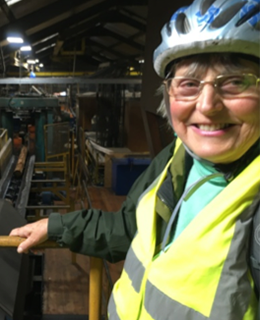Mrs Ruth Tittensor
Honorary Research Fellow

Mrs Ruth Tittensor MA, MSc, CBiol, FRSB
Independent Chartered Biologist, Ecologist and Historian
When a student at Oxford, a perspicacious woman lecturer suggested to me that a critical decision for my future career would be whom I chose as a husband! In due course, having acquired a Botany degree and a research degree in Ecological History from Edinburgh, I took her advice and also acquired the perfect chap . . .
My subsequent research projects have been determined – firstly – by what could be fitted in with running a household, bouts of mental ill-health and – secondly – by what I could persuade landowners, residents, statutory and voluntary organisations or grant-givers, is important, interesting and worthwhile.
The Chilgrove Valley Landscape Project was a 10-year, eye-opening, interdisciplinary study of the 6,000 acre West Dean Estate on the chalk South Downs by archivists, an archaeologist, ecologist, estate workers and continuing education students. My 4-year project on The Mens (Old English origin 'ge-mӕnnes': joint tenancy) transhumance-woodland on the heavy-clay Weald, involved naturalists and professional botanists working together to survey the tree populations, flowering plants and vertebrates, with assistance from archivists in our historical studies.
During such projects, interested amateurs learn field-work methods, landowners discover the natural and cultural content of their estates and how landscapes change. We provide them with survey results and pragmatic management plans, while local people and visitors value our booklets, articles, maps and talks – and the habitats themselves.
North of the border again, I started a five-year oral history Project on Afforestation of the Whitelee Plateau, Ayrshire. This idea of historian Professor Chris Smout and forester Mr Richard Toleman was that the memories of people who represent the work force which increased the tree cover of Scotland from 6% to 17% between 1960 and 2000 AD, should be recorded before it was too late. I recorded 60 remarkable people and documented the times when pre-electricity, hard-labour farming gave way to hard-labour, manual forestry and then mechanised forestry. Concurrently, the Whitelee Plateau was altered from boggy-moorland-farmland needing three acres to support one sheep – into 15,000 acres of Sitka spruce forest with no sign of sheep or people.
Contributors received copies of their audio recordings and transcripts; they felt a sense of pride at bequeathing posterity the detailed history of their working lives which had produced such comprehensive landscape and social change.
Recordings and Transcripts are available at the National Museum of Scotland, Edinburgh; Forestry Commission, Alice Holt, Surrey; online. And two books cater for different audiences.
I recently decided that as the strident public dissent on the 'Conifers v. Broadleaves' issue had not yet abated, I would do the research to prepare an unbiased account of Sitka spruce in its native Pacific North America and new homeland of Atlantic Europe. This fascinating project necessitated, for instance, attending a class on basket-making using Sitka spruce roots, following the trail of Spruce Beer (delicious!) and crawling under an Usher Hall grand piano to see the soundboard! My recent book, 'Shades of Green: An Environmental and Cultural History of Sitka Spruce' tells its remarkable story.
While assisting my husband with his research on rabbit biology and ecology, I developed a long-term (and culinary!) interest in the history and ecology of Rabbit Warrens. My other ongoing project, also with culinary overtones, concerns non-farmed foods and their relationships with land use. I intend to forge ahead on these research topics while associated with the CEHP.
My Ethos is to work mainly in the 'general countryside' and on research relevant to a community and to current problems. I encourage non-specialists and often publish in provincial journals so that results are easily available in a locality.
Selected publications are here: Ruth Tittensor Selected Publications.docx
